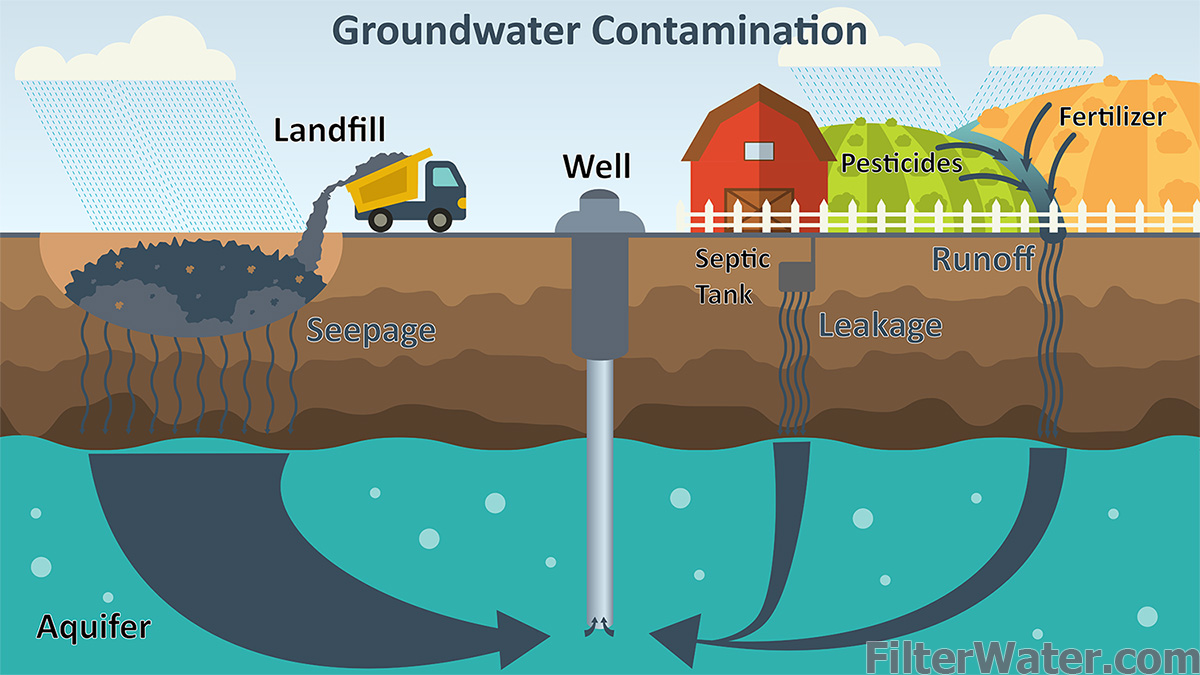Well and Ground Water Contamination
Related Topics
Important Topics
- Acidic (low pH) Drinking Water
- Arsenic in Well Water
- Barium In Well Water
- Cadmium in Well Water
- Chloride in Drinking Water
- Chromium in Drinking Water
- Coliform Bacteria in Drinking Water
- Color in Drinking Water
- Copper in Drinking Water
- Cyanide In Well Water
- Environment Guide
- Fluoride in Drinking Water
- Iron in Drinking Water
- Lead in Drinking Water
- Mercury in Well Water
- Nitrates in Well Water
- Nitrite in Drinking Water
- Odors in Drinking Water
- Pesticides in Drinking Water
- Radium in Well Water
- Selenium in Drinking Water
- The Effects of Water Pollution
- Turbidity and Cloudiness of Drinking Water
- Viruses in Drinking Water
- Water Contaminants
- Water Pollution
- Well and Ground Water Contamination
Important Topics
Published on 8/20/2015
A particular area of concern for many people is groundwater contamination. Groundwater is usually defined as water that lies below the surface of the land. For practical purposes, though, groundwater is usually thought of as water underground that can be removed by wells. Those sources of ground water are referred to as aquifers. When an aquifer becomes contaminated, that contamination can affect a wide area – and take years to clean up. Some common sources of groundwater contamination include improper disposal of wastes, faulty septic tanks, landfills, pesticides and fertilizers.The diagram shows the several ways that groundwater can become contaminated. When a source of groundwater for wells becomes contaminated, it can affect the drinking water for miles around.

One of the most common sources of groundwater contamination is runoff from rain that carries with it pesticides and fertilizers from agricultural fields, or that percolates through the earth beneath a landfill. Home septic systems are another major source of groundwater contamination. The effects of groundwater contamination can’t be overstated. A study conducted at the Marshfield Clinic in Wisconsin estimated that 50% of all waterborne diseases treated were the result of drinking well water contaminated by septic systems.
Groundwater contamination is particularly insidious because of the slow movement of water through aquifers. Contamination introduced into an aquifer can show up years later at a site far removed from the original source. Two other factors contribute to the severity of the problem: groundwater through wells is the source of more than 20% of the country’s water supply, and the EPA does not regulate the water quality of those wells – it is up to the individual owner to test and assure himself of the safety of his water.
If your drinking and household water is supplied by a private well, it’s vitally important that you are aware of the contaminants in water that you should test for, and the well filter systems that will remove them. The EPA recommends periodic testing of well water for total coliform bacteria, nitrates and lead. The recommended guidelines for testing your well water are:
| Coliform Bacteria | Once a year |
| Nitrates | Once a year |
| Sodium, sulfates, manganese, iron, lead | Every three years |
| If you know of pollution sources nearby: (farms, landfills, toxic disposal sites, etc) | Twice a year for any suspected contaminants |
In addition, you should test your well water for contaminants if:
The well water filter that you install should be one that is effective in removing any well water problem that the tests show. The EPA web site at www.epa.gov contains full tables of all common well water contaminants, and recommendation for the best well water filter system for each.
If you have concerns or questions about the quality of your well water, need a list of water testers in your area, or want to find out if there has been contamination reported in your area, the EPA maintains a Drinking Water Hotline that can be reached at: 1-800-426-4791.
Want to test your Drinking Water? We have many Water Testing Kits available, ready to be shipped, including Photometers and Laboratory Test Kits.

| First Created: 2006, Last Updated: Oct 24th, 2014 - 15:14:56 |

 View Cart
View Cart